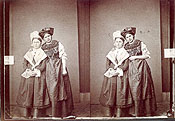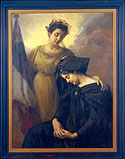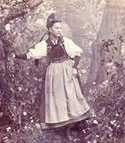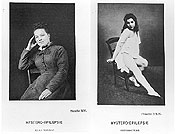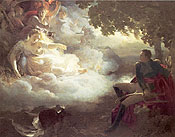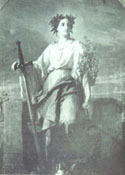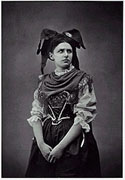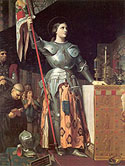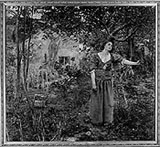The browser will either open the file, download it, or display a dialog.
|
|
Young Women in Old Clothes: The Politics of Adolphe Braun's Personifications of Alsace and Lorraine |
||||||
|
Adolphe Braun's personifications of the French border provinces of Alsace and Lorraine as young girls in regional costume were photographed about 1871, at the time of the Franco-Prussian war when the provinces were ceded to Prussia (fig. 1). Intended to illustrate the sorrow felt by the provinces at being torn from France, the images were immensely popular, appearing on dishes, posters, flags, and other objects, and can still be found on tourist items in Alsace. The metaphoric use of the human body renders it a map of social relations and these geographical "portraits" are no exception. They provide a provocative case study of the interplay between class, gender, and nation in France in the latter part of the nineteenth century. Moreover, these are living human bodies that were configured by the relatively new medium of photography then considered an objective, mechanical, and "realist" form of representation. Braun's use of photography for political allegory thus highlights the negotiations and tensions between actuality and symbol present in all representation. | ||||||
|
A striking departure from the norm for such emblematic figures is the regional folk costumes worn by "Alsace" and "Lorraine." Unlike the generic pseudo-classical drapery that was usually the case, as in Emmanuel Benner's The Loss of Alsace and Lorraine painted fifteen years later (fig. 2), Braun's choice of traditional local attire clearly situates his subjects within a social as well as a geographical context. His models are country girls. Their highly constructed symbolic value is grounded in their very provincialism. | ||||||
| Braun's was an astute choice. While representations of folk costume were not new at the time, their implications were particularly charged during the second half of the nineteenth century, when both traditional cultures and natural landscapes were being destroyed or absorbed by a fast-changing, industrialized world system. Deborah Bright has convincingly argued that in photographing Alsatian landscapes and sites for his album L'Alsace photographiee (1859) Braun was consciously documenting a way of life that was thought to be rapidly slipping away with the growth of industry.1 Another aspect of a symbolic resistance to the increasing use of machinery was the selective breeding of farm animals, begun in France in the 1850s. Braun himself raised prized cattle and horses on his farm at Dornach, and in the early 1860s he photographed them as well.2 | |||||||
| The mid-nineteenth century is also the period when the Folklore movement in France began in earnest with the collection of folktales and artifacts, the surge of interest in keeping with the concurrent establishment of anthropology and ethnography as distinct areas of academic study in France. The market was flooded with representations of costumes and ethnic types of all sorts. In addition there were historical studies of provincial life, as well as novels, paintings, and sculpture with peasants as subjects. Many illustrated publications were produced in inexpensive formats, suggesting a widespread dissemination at all levels of society. | |||||||
|
|
|||||||
|
Ever the shrewd businessman, Braun had already capitalized on this interest. Shortly before his Alsace and Lorraine pictures he had produced an extensive series of photographs of Swiss costumes (one or two for each of the twenty-five cantons existing at the time; fig. 3). Although these were intended to depict traditional regional dress primarily for a tourist market and not as a political manifesto, they inevitably served allegorical functions as well, feeding into a profound sense of nostalgia for the last exemplars of autonomous local cultures. | ||||||
| As with his Alsace and Lorraine, Braun's Swiss models are never actively engrossed in any work, although they often hold a broom, a walking staff, or a bit of needlework. This pictorial idleness distinguishes them from representations of ethnic types plying their trades, a related but different genre. Folk costume illustration, in merely hinting at possible occupations, tends to congeal the scenario into one eternal pause, thus satisfying the modern Western tourist's quest for an "authenticity" that, as Dean MacCannell has defined it, is typically positioned in the past, unchanging, without an internal dynamic.3 Photography—often described then, and now, as congealing actuality into a kind of eternal rigor mortis, was especially suited to relay such a sense of timelessness.4 | |||||||
| The authenticity of Braun's photographs, however, has glaring inconsistencies. The costumes themselves are well researched and accurate but they are often clearly inappropriate for the occupations suggested by their illustration. Women are pictured wearing their best holiday finery—elaborate headdresses, silky aprons, lacy mitaines—while standing among brambles, on jagged mountain paths, or holding a large wooden bucket and the like. But this is of little consequence for the pictures' credibility. Braun's tableaux, all photographed in his garden at Dornach, are openly and declaredly theatrical and, appropriately, bad theatre at that. The elaborate backdrops and props give themselves away as such. Like the stage sets, performances, and tableaux vivants from which they are derived, Braun's costume pictures depend on the viewers' familiarity with the genre and consequent acceptance of its contrivances.5 Included within these genres are representations of foreign peoples, such as Africans and Australian Aborigines, as objects of living theatre at national and international fairs beginning in 1860. Falling somewhere between science and popular entertainment, "native" settings and props were peopled by costumed "natives" themselves. These living subjects teetered between existence as real flesh and blood and as inert displays of ethnographic history, an oscillation that occurs in costume photographs as well. | |||||||
|
|
|||||||
| Braun's costume photographs also refer to paintings of country life, which had become immensely popular in France by the 1860s as he was working on the Swiss series. While some paintings presented a bucolic, idealized peasant existence, others showed the hardships of rural lives, implying a social consciousness. Like all costume illustrations, Braun's images clearly work to deny the harsher aspects of life outside the metropolis, as well as any signs of the modernization that had disrupted that life, a denial that was essential to their success as commodities within a tourist industry. | |||||||
| An elimination of any indication of hard work, poverty, or modernity was also necessary for the fabrication of an innocent, healthy country life to serve as a contrast to the supposedly decadent life of the contemporary Parisienne, a figure that had become symbolic of the allure and treachery of modernity. All the Swiss models are young, robust women, despite the fact that it was mostly an older generation that actually wore the costumes that they display, and despite the existence of many elaborate Swiss costumes for men—and plenty of robust young men to model them. Their youth and gender is in keeping with their emblematic status. Women as emblematic tropes tend to displace actual historical women, one of the reasons they are so useful as representative of sites that are traditionally male dominated.6 | |||||||
| Their folk costume also clearly defines them as provincials. With the beginning of mass production and the opening of the first department stores in Paris in the 1850s, the use of clothing to indicate social difference among women became especially problematic. Those from supposed "inferior" stations in life could assume the appearance of those in the social ranks "above" them, posing a threat to the dominant classes. Visual demarcations of social boundaries, as well as geopolitical boundaries, could be—and were—negotiated. | |||||||
| Much of the fuss over Courbet's Demoiselles on the Banks of the Seine of 1856 was because these girls from the lower classes, lounging in an unseemly provocative manner in public, were dressed in high fashion. Folk costumes, on the other hand, remained timeless and unchanging even in an urban context, such as in one of Braun's photographs of the canton of Basel where the model has been placed in front of a painted city backdrop. Indeed, such a setting emphasizes the unequivocal opposition of traditional dress to the concurrent socially mobile and constantly changing urban fashions. | |||||||
| The materialism and frivolity evidenced by the extravagant sartorial whimsies of the Parisienne and her imitators were, in turn, related to a much-lamented decline of morals in French civilization; the material body and the body politic collapsed into one and the same. In this, the decadence of contemporary urban life had specific political overtones, as it was often attributed to the modernization promoted during the regime of Napoléon III. Thus the loss of Alsace and Lorraine, as Braun's young women in regional costume, becomes a moral, ethical loss as well as a political, territorial one. (It should be pointed out that Braun's knowledge of the workings of urban fashion was direct. His first career, which began in Paris in 1834, was as a designer of textiles, mostly for wallpaper and furniture. He continued this successful business in his home territory of Alsace from 1843 until 1872, although by the mid-1850s his growing photographic company took up most of his attention.) | |||||||
| In addition to the restricted social mobility implied by folk costumes there are also the restrictions such clothing imposed on the female body itself. Whereas a nineteenth-century woman clad in loose garments (even classical Greek drapery) could easily suggest loose morals—in high art as well as in pornography—those bound within the tightly laced bodices typical of most provincial costumes were respectably contained. Braun emphasizes this aspect of clothing in his Swiss series, often showing both the back and front of such bodices. True, the fashionable Parisienne was also tightly bound within her corset at the time, but the corset was an item of vanity, extending below the waist and known to wreak havoc on the body of she who wore it, affecting sexual intercourse, gestation, and childbirth. Corseted, the Parisienne was no longer a "natural woman." | |||||||
| Braun's country maidens, including Alsace and Lorraine, are also all bonneted, an important sign of respectability. Flowing hair, like flowing clothing, easily signified questionable morals. The unrestrained red hair of Manet's Olympia (1863) was as much a recognizable sign of her occupation as was the black cat at the foot of her bed. Disorderly tresses were also considered signs of madness, a condition in women closely associated with a deviant sexuality. In Iconographie photographique de la Salpêtrière (1876–77) by the influential French psychiatrist Jean-Martin Charcot, female patients in a state of sanity are all neatly coiffed, their dresses tightly buttoned up to their chins, while those in a state of lunacy have lost control of their hair as well as their clothing and emotions (fig. 4). An 1856 illustration based on photographs by the English doctor Hugh W. Diamond maps the progressive mental health of a psychiatric patient primarily by her hair, which becomes less and less unruly in each sequential picture. The final image has her locks completely tamed by a large bonnet tied under her chin and her body ever more modestly hidden under layers of clothing. | |||||||
| Women in folk costume are never looking directly and boldly at the camera, unlike Manet's Olympia and many contemporary women in photographs from the period, usually those who wore little or no clothes at all. True to form, Braun's country women avert their eyes in a modest, unfocused manner. In all of his photographs of Alsace and Lorraine, whether they are shown together or singly, they both gaze off to one side. In this case, the sidelong glance was intended to suggest a sorrowful look toward France, the country from which they had been wrenched. The obliqueness of their gaze, however, also declares their difference from the shameless hussies who stare boldly out at the viewer. | |||||||
| It is hardly coincidental that Braun's country maidens appeared on the market at a time when objections to pornographic photographs—in reaction to the increasing number of studios in France in the mid-1860s that were producing not only nudes but explicit depictions of various sexual acts—were coming to a head. The market was also full of the breasts and bellies that characterized so many "Oriental" postcards churned out for the tourist business. | |||||||
| The physical body and the national body politic were inextricably linked to a rhetoric of physical as well as moral degeneration. Not only did there emerge a physical stereotype of the city dweller as stunted, weak, and sickly, a prevailing theory of hereditary urban degeneration was that these weak urbanites would go on to produce genetically, never mind environmentally, unhealthy offspring. Despite evidence to the contrary, there was the widespread belief that the laboring poor in the countryside were inherently healthier than their urban counterparts. In turn, such good country health implied moral superiority. Certainly, the youthful, robust, uncorseted—but tightly bodiced and presumably virginal—female models presented by Braun fit the bill for conceptualizing the physical and moral health that country life came to symbolize. | |||||||
|
|
|||||||
| The idealization of country life and its moralizing overtones as well as the openly theatrical aspects of costume illustration lent themselves readily to Braun's construction of Alsace and Lorraine. Not only did he have considerable practice in the genre, it was one familiar to his viewers as well. Alsace and Lorraine are depicted as young, robust women, as are Braun's Swiss models, and their costumes, like the Swiss ones, are authentic. | |||||||
| Braun's choice of folk costume for Alsace and Lorraine can also be seen in a more direct political context, as a response to the program initiated in the 1860s by Louis Napoléon to stimulate French awareness of Alsatian culture and history throughout the country. His was a strategy intended to promote government favor within the province as well as to impress its value upon the country as a whole. There was, for example, a government-sponsored exhibition of Alsatian painters in Paris in 1864, an event that would serve both purposes. Alsace and Lorraine were particularly important provinces in the efforts to centralize the government of France at the time. The two regions had been part of the German Empire until the seventeenth century, when France began to regain them piecemeal (the process being completed only in 1766). Like Switzerland, Alsace and Lorraine were particularly transitional and hybrid in terms of nationality, language, customs, and religion. Alsace especially was of considerable economic value, being a highly industrial area with coal and iron mines, steel mills, and factories. | |||||||
| The contradiction in representing an industrial region by a woman in folk costume, which associates her with an agricultural setting, has its logic. While Braun's Alsace and Lorraine are not costume illustrations, as is his Swiss series, his use of local dress takes on many of the implications of the folklore movement of the time. In regional country dress, Alsace can be read as a symbolic contrast to, and denial of, the many social problems existing in the very industrialized urban center she represents. At the same time, Braun differentiates Alsace and Lorraine from his Swiss costume photographs in several ways that emphasize the primacy of their emblematic functions. For example, though the Swiss photographs are replete with elaborate backdrops and props, his Alsace and Lorraine are removed from any background that could distract the viewer from their symbolic purpose. | |||||||
|
|
|||||||
| In addition, Alsace and Lorraine are modeled and posed so as to refer to other well-known emblematic female figures, of which there was a plethora. The female figure was, in fact, the prominent national allegory in nineteenth-century France. In general, personifications have proved to be well suited to bring the more abstract complexities of political life closer to the individual in ways that can be easily assimilated and, more importantly, experienced in a highly personal, bodily manner, evoking strong passions. As Freudian and Lacanian psychoanalytic theory would have it, it is through our own bodies that we first experience boundaries, that we first learn the differences between inside and outside, self and other, interior and exterior. This early microcosmic experience then remains a part of our adult macrocosmic experience of the world, rendering the body a powerful emotional metaphor and symbol.7 | |||||||
| Various explanations have been given for the pervasive symbolic use of women, rather than men, during the nineteenth century in France. There is the Roman tradition of illustrating civic values such as Justice or Liberty with female figures and, in psychoanalytic terms, the importance of the maternal body in early development. Most immediately relevant is that, as Lynn Hunt has written, a different type of national representation had to be forged for the new republic following the desacralization of the king by the revolution.8 Indeed, it is a stalwart woman who decorates the first seal of the new Republic in 1792. Although female personifications of France existed previously, someone like Jean Giraudoux could still write of the French Revolution that, "to change a country from a kingdom (un royaume) into a Republic (une République) was to change its very sex."9 The figure of the new Republic, modeled after that of Liberty, also signals a change in class, as she came to be called Marianne, a popular name among the lower classes and peasantry. The three designations—Republic, Liberty, and Marianne—were often used interchangeably. | |||||||
| In this change of sex, choices had to be made between two major styles: the robust allegorical woman of Roman antiquity, or the curvaceous, milky-white femme, a holdover from the eighteenth century. She can be seen, for example, in Jean-Pierre Franque's depiction of a helpless, pleading France in his Allegory of the Condition of France before the Return [of Napoléon Bonaparte] from Egypt (Salon of 1820; fig. 5). The weakness and voluptuousness appropriate for the message of Franque's painting was hardly suitable to convey a sense of a strong nation and, for the most part, the more forceful iconic figure prevailed. | |||||||
| In one of Braun's most frequently reproduced versions of Alsace she bears a striking resemblance to Charles Landelle's Republic (a very typical one) painted during the Second Republic in 1848 (figs. 6, 7). A description of Landelle's canvas by the critic Louis Desnoyers could easily be that of Alsace: She is "a tall, beautiful girl [standing] in an attitude of calm strength. . . . Her gentle but proud glance is in sympathy with undeserved suffering of every kind. Her broad, intelligent brow can effortlessly encompass every useful or generous idea; her countenance, which is both benevolent and proud, expresses self-respect as well as respect for others. . . . [She is] disdainful rather than angry."10 | |||||||
| Although the Second Republic was short-lived, during the subsequent Second Empire—the main period of Adolphe Braun's photographic production—images and statues of Marianne persisted. Public examples were hastily removed but smaller objects remained in homes. And, immediately after the fall of the Empire in 1870, figures of Liberty and the Republic reappeared. Auguste Bartholdi, for one, who was from the same region as Braun, began designing his famous statue of Liberty shortly after Braun made his Alsace and Lorraine photographs. According to one observer in the 1860s, some peasants believed Marianne to have been an actual person, a belief that may be due, in part, to the many theatrical pageants during the time of all three French Republics where ordinary young women played the part of the Republic, events that Braun would have known through the telling if not first-hand. | |||||||
| At the same time that Marianne was coming into being as a symbol of the French Republic, the fifteenth-century figure of Joan of Arc was undergoing an unprecedented revival. During the nineteenth century there were Joan of Arc operas, eighty new plays, novels, and historical books. But her symbolic uses change over the course of the century. Her image has been altered significantly during the twenty-five year span that separates Ingres's painting of Joan as a warrior (1854; fig. 8) and Bastien-Lepage's depiction of her as a peasant girl (1879; fig. 9).11 By the time of the Franco-Prussian war, for example, Joan had become a figurehead for the avid interest in regional folklore. The resemblance of Braun's Alsace in her facial traits and in the pose of her head to both the Joan of Arc by Ingres that preceded and to that by Bastien-Lepage that followed, is striking and probably not a coincidence. Braun may well have taken his cue from Ingres, and Bastien-Lepage may well have had an eye on Braun as well as on Ingres. | |||||||
| Alsace also resembles a figure in a contemporary painting by Gustave Brion, a popular Alsatian artist living in Paris. Like Braun, Brion paid great attention to ethnographic accuracy; his parents sent him Alsatian costumes, which he used for the Parisian models he posed in his studio. Also like Braun, Brion is known to have been very attentive to the taste and expectations of his public, modifying certain of his paintings to suit his clientele's aesthetic tastes as well as their political leanings.12 | |||||||
| Brion's Vosges Peasants Fleeing before the Invasion (1867) depicts villagers fleeing the invading Prussians during the last days of the empire of Napoléon I. Painted to satisfy the politics of Napoléon III as Alsace and Lorraine were again in evident danger of being taken over by the Prussians, it commemorates the peasants who chose to leave their land rather than be dominated by a foreign power. It is significant that a woman, not a man, leads the group, encouraging an allegorical as well as an historical reading. Whether or not intentionally, the features and the turn of head are echoed in Braun's representation of Alsace three years later. | |||||||
| Despite these strong allegorical women (the very reason for the female allegorical figure), women were not only considered the "weaker sex" but, according to Darwin among others, members of a lower, "primitive" species. | |||||||
| The exclusion of males from Braun's Swiss photographs is an indication that they, too, were intended to serve purposes beyond that of costume illustration. Given the circulation within the popular metaphorical use of folk women at the time, the inclusion of men in the series would have situated them on the other side of an allegorical divide, that is, alongside women as backward in evolutionary time. Also, the often colorful and highly decorated Swiss male outfits were hardly appropriate symbols of virility in an urban context where men had expunged almost all color and frills from their wardrobes. | |||||||
| Yet it was the very same qualities of "intuition," "primitiveness," and "instinctiveness" attributed to women that placed them ideologically inside, at the spiritual center of the nation, in the sanctity of the home, in opposition to a male, material outside. And, as the sanctified guardians of cultural tradition and morality yet weak and vulnerable, woman must be protected by men, who were defined as the active, warrior defenders of civilization. | |||||||
| As icons of a geopolitical entity, Braun's Alsace and Lorraine were not exempt from the manipulations of the gendered and sexualized vocabulary of international politics that was blatant at the time (as it continues to be in Western culture). The widespread metaphorical image of a highly potent conquering male (if not an outright rapist, depending on which side the description comes from) was current in nineteenth-century France. An example of the masculinization of conquest is the terminology used in describing the Suez canal opened in 1869, less than a year before the Franco-Prussian war. "It is there," the St. Simonian Père Enfantin declared, "that we will perform the act the world is waiting for to prove that we are males!"13 The French word he emphasizes is mâles (males) and not hommes (men), thus giving his statement lusty, even bestial, overtones. Braun himself did not go to Egypt on this occasion but he did send his son Gaston to take photographs, knowing that there would be an increased market for them upon the completion of such a long, ongoing project. | |||||||
| Needless to say, actual women were, and are, all too often raped in wartime, contributing to their identities as victims rather than as active fighters. Apparently the Prussians, aware of the actual or potential emotional response to Braun's Alsace and Lorraine, attempted to diffuse the impact of these images by claiming that the model for Alsace was actually the fiancée of one of their officers. Whether or not this story served its purpose to configure the Prussian takeover as an honorable engagement rather than a forced rape, it is indicative of a realization of the degree to which international conquest was gendered and sexualized. Such a tale also says something about photography. Not only would it serve to make Alsace legitimately Prussian, both as a person and as a territory, it would also undermine the iconic value of her image by recalling to its surface the actual woman who had stood in front of Braun's camera. As photographed beings, Alsace and Lorraine oscillate between symbol and reality. Paradoxically, their existence as living women could be used to increase their emotional symbolic value (through viewer identification) as well as to detract from it (she is real, not ideal). | |||||||
| Braun could have chosen to portray Alsace and Lorraine as more vehement, forceful figures (as is Delacroix's Liberty of 1830, for example), thus leaving no room for a reading of their willing submission to the Prussian(s). But this is unlikely. Calmer female iconic figures were prevalent at the time to signify the stabilizing power of reason rather than a fervent call to battle.14 Braun's choice of a subdued and compliant Alsace and Lorraine can also be seen as a reaction to the rise of feminism in late-nineteenth-century France with its accompanying threat for empowered men. | |||||||
| There is another factor as well, the widely known and striking presence of fighting women on the streets of cities and towns in France during the nineteenth century throughout its episodic revolutions. These women, mutinous and lower class, threatened to undermine longstanding essentialist readings of gender difference according to which men are warlike and women are pacifist and passive. The strong presence of women Communards on the streets of Paris in 1871, just at the time the French were surrendering to Prussia, was especially troubling. | |||||||
| The response of the oppositional upper classes and aristocracy was to pathologize les pétroleuses, as all women who were involved in the fighting were designated because of the oil (pétrol) with which they ignited fires. While the ultra-conservative writer Maxime Du Camp may be extreme in his vituperative depictions of the pétroleuse as a sexualized madwoman whose lewd and promiscuous animal instincts have come to the fore, his four-volume book on the Commune constitutes a discourse on the feminine of that period.15 As Janet Beizer has argued, Du Camp's book demonstrates the vitality of the concept of woman to nineteenth-century narrative structures, "even those that have ostensibly little to do with her."16 | |||||||
| The Commune as an event is also figured as female, the political pathologized along with the rebels themselves. For grammatical reasons, of course, la Commune is consistently referred to as elle and, by extension, personified as a woman, but this does not account for her feminization within a web of associations spun around female sexuality run amok, rendering "her" a convulsed mental patient like those in Charcot's photographs, her clothing and hair in disarray (fig. 4). With the Commune the hystericized body of woman threatened to depose forever the symbolic body of the king. | |||||||
| In photographing Alsace and Lorraine in 1871 it was politically expedient for Braun to avoid any signs of a rebellious woman and depict the two as very much under control and dominated, even if by the enemy. In this way the woman outlaw could be "harnessed," as was Joan of Arc as she shed her armor over the course of the century to become a simple peasant girl listening to a voice from the heavens.17 | |||||||
| Braun's political stance regarding the Commune is not clear, although he was one of several photographers who pictured the ruined buildings of Paris. In his work and in his personal life he seems to have kept himself away from any direct political involvement. What is evident is that he was sincerely attached to his native Alsace, moving back to his hometown when his first wife died after he had been in business in Paris for ten years. Undoubtedly he thought of himself as a Frenchman (his Alsace and Lorraine alone are testimony), although when the provinces fell into Prussian hands Braun chose to remain there as a German citizen. He did not, however, relinquish any of his French commercial connections, sending one of his sons to set up a branch of the business in Paris as a French citizen. Clearly Braun, though remaining on the sidelines, was nonetheless highly attentive to the social and political currents of his time. When the opportunity arose he got to have his cake and eat it too. | |||||||
| This is not to say that Braun did not take any professional risks and experience business failures. (His large still lifes, intended as items of home décor, were ahead of their time and a commercial flop.) The allegorical use of a female figure in folk costume also had its problems and risks. The public enthusiasm for folk traditions was not without ambivalence toward what were considered their "primitive" and "regressive" characteristics, the same qualities by which women were defined. Representing the provinces presented a dilemma; viewed as "old," they had little place in the modern world of the nations, yet their symbolic value lay in the supposed simple, bucolic life they represented. This dilemma took on specific political dimensions. At the same time the government of Napoléon III supported and encouraged the documentation and preservation of traditional provincial culture, especially that of Alsace and Lorraine, it also sought to break down provincial loyalties and reinforce peasants' allegiance to a central power. | |||||||
| In actual practice, the decrease in farming and the rise in industrial production spurred a migration of farm girls to Paris and other urban centers. Many found work in factories or as servants but many also had to resort to prostitution to make a living. Many painters' and photographers' models, especially those who posed in the nude, were prostitutes and, at times, the very same women who were dressed up in folk costume as modest country girls. The criticism of Marianne—that peasant and lower-class emblem of the Republic—for "selling her favors" in moments of weakness, compromise, or corruption had its basis in actuality. | |||||||
| These demure country girls showed other stains of impurity here and there. The contrast of their swathed and laced bodies to those of the bare-breasted odalisques in "Oriental" postcards was only skin deep. Although the terms may differ, the classification of these European peasant girls as foreign "types" is the same as for their Oriental counterparts, part of the same general construction of exoticism. Both identities are determined by a dominant system exterior to them. Both are products of a colonialism reaching out from the center toward the peripheries. | |||||||
| Braun's country lasses may suggest a more virtuous version of the lure of the Other, but they satisfy a similar desire for a woman who was supposedly more free and sensual than the (over)cultivated bourgeois urban wife. An indication of this is the use of French folk costume as a form of sexy masquerade by the Parisienne, an active participant in the rage for cross-cultural (and cross-gender) dressing during this period. To give only one example, the Contessa Castiglione, that gorgeous, flamboyant Italian living in Paris and the mistress of Napoléon III, would often have herself photographed in various guises, particularly those that reminded her of a special occasion. One is a Normandy peasant outfit she wore to a ball during which she went off to a remote boudoir of the palace with the emperor, who is said to have emerged some three hours later in a very good mood. | |||||||
| Traditional dress could be deceptive, even when worn by country girls. According to Ruth Kilgour, the big Alsatian bows are directly descended from what were known as "kiss curls" at the nape of the neck in French seventh-century court fashion.18 The bows that came to replace them were called kiss-me bows, or Psyche knots. In the early nineteenth century these bows appeared on the back of peasant caps in Alsace and were switched to the front of the cap at mid century. Red bows were for Catholics and black ones for Protestants, originally intended as a warning for members of one religion not to kiss those of another. Regardless of such a heritage, the bows have been seen as sexy. One writer describes them as immense trembling (fremissant) butterflies.19 Braun's Swiss girls also have a hint of allure and vanity—a modest lift of the skirt here, a bit of primping there. | |||||||
| Lorraine can be read as quite fetching in her demure way. Alsace, however, shows few signs of coy femininity, suggesting a touch of symbolic masculinity, especially when the two are shown as a pair. This character difference is in keeping with descriptions of the two provinces, whereby the women from Lorraine are consistently described as meek, austere, gentle, and a bit sad. Those from Alsace, on the other hand, are seen as extroverted and exuberant. In one instance, the Lorraine woman is compared to a massive Romanesque cathedral, best known for its interior, while the Alsatian is likened to the exuberant exteriority of a Gothic cathedral. As the interiorized figure, Lorraine would have been understood as feminine, and the outgoing Alsace as masculine. Whether consciously or not, in one photograph Braun has depicted Lorraine looking left (a backward gaze that can also be read as toward an interior). Alsace, on the other hand, looks toward the right (a forward gaze that can also be read as exterior). It is significant that, although Joan of Arc was from Lorraine, she is usually represented more in the character attributed to an Alsacienne, at least until the end of the century. | |||||||
| Braun was undoubtedly fashioning his provincial pair according to their commonplace and therefore easily recognizable stereotypes, but these stereotypes also served another purpose. Coupled together, the submissive femininity of one tempers the more forceful self-reliance of the other. As a pair they resolve the problem of having to combine these conflicting qualities in one personage. It is not surprising that it was the stronger figure of Alsace, potentially more threatening, that the Prussians chose to designate as the fiancée of one of their officers. | |||||||
| Since the beginnings of photography, its images have moved fluidly between scientific and popular contexts, fact and fiction, the same photograph often serving as both evidence and expressive interpretation. In this, photography exemplifies the permeability of the divide between fantasy and actuality, between the individual world of libidinal desires and the social world of politics and economics. In studying photographs, as Walter Benjamin has said, "the historian takes on the task of dream interpretation."20 It is a task that continues. Joan of Arc is still a major figure in French politics, now as a figurehead for Aryan Folk worship in the National Front's campaign against immigrant workers. Marianne is also alive and well, continually reincarnated as Brigitte Bardot, Catherine Deneuve, or, more recently, the model Laetitia Casta, who has upset the French by her plans to move to London. | |||||||
|
1. See Bright 2000. 2. Other photographers depicted farm animals at the time. Whereas many of these images were intended to serve as models for painters, Christian Kempf argues that the interest in them went beyond such a category; see "Les animaux de ferme," in Kempf 1994, pp. 43-44. 3. MacCannell 1976, p. 63. 4. A sobering testimony to the power of such collective desire for an unchanging, immobile past is that it became a reality for folk attire as the increasing documentation and preservation of local dress tended to discourage any modifications that would have come about in a normal course of evolution, thus preserving it in a time warp apart from daily life. 5. Jeannene M. Przyblyski (1995) has convincingly challenged the commonplace opinion that viewers of photographs at the time tended to accept all but the most blatantly manipulated images as factual. In writing about photographs of the Paris Commune in 1870 she sees an increasing consumption of reality as artifice, precisely at the time Braun was photographing his Swiss costumes and Alsace and Lorraine. 6. See "Introduction," in Kaplan, Alarcón, and Moallem 1999, p. 6. 7. I am indebted here to Yew 1998. 8. See Hunt 1984. 9. As quoted by Agulhon (1979) 1981, p. 185. 10. Review of the Salon of 1848 as quoted by Agulhon (1979) 1981, p. 77. 11. For the similarity of Braun's Alsace to Bastien-Lepage's Joan of Arc I am indebted to O'Brien 2000. 12. Weisberg 1981, p. 276. 13. As quoted in Berchet 1985, p. 20. 14. See Agulhon (1979) 1981, esp. p. 187. 15. Du Camp 1879. 16. Beizer 1993, pp. 212-13. I am indebted to Beizer's essay for further readings derived from several of her citations, in this instance, Schor 1985. 17. I borrow the phase from Marina Warner (1985, p. 292) who, in her discussion of an Amazon image of liberty that emerged in France in the first part of the nineteenth century, remarked, "By harnessing the figure of this outlaw . . . the Liberty image brings her under control." 18. Kilgour 1958, pp. 132-33. 19. Marin 1966, p. 57. 20. Benjamin 1983-84, p. 10. |


